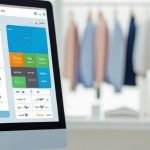How to Use Your Checkout Counter to Make More Sales
Your checkout counter is where a shopper becomes a paying customer. It may feel like your biggest challenge lies in getting people to the checkout counter to in the first place — and that’s definitely a big retail accomplishment.
But you can optimize the checkout counter itself to make more sales. Interactions with customers here offer opportunities to add value to the shopping experience, promote customer loyalty, and of course, to sell just a little bit more.
Here are four strategies you can use to boost the sales-generating power of your checkout counter and the employees who work it:
Allow for Impulse Purchases
The checkout counter around your POS system is the ideal place to stock merchandise most often bought on an impulse. Shoppers make impulse buys for a number of reasons and they act on them; because their immediate happiness and pleasure derived from picking up something new outweighs the thought of a consequence sometime in the future.
Customers approach the checkout counter to make a purchase, so they already made the decision to spend. Therefore, it’s easier to subtly suggest making small, impulse purchases once a shopper stands at a checkout counter ready to make a purchase.
At this point in the shopping experience, a customer already made several decisions. When they reach the checkout counter, they could be hitting decision fatigue — and therefore, their willpower to say no to additional purchases takes a hit.
Encourage shoppers to make impulsive purchases by stocking your checkout counter with relatively low-price, merchandise that delight your most common customers. Also, POS systems provide with a customers’ order history so you can track the most frequently bought items and stock up on them. By filling up the checkout counter space with essentials, customers are sure to buy them.
Anticipate Basic Needs and Provide for Them
Instead of anticipating a shopper’s impulses, anticipate their needs and provide useful solutions.
One way to do this is to stock your checkout counter with frequently forgotten items. You could also stock products that customers don’t usually think about buying, but actually need. What you choose to strategically place around your registers will depend on what kind of products your offer. However, ask yourself the following questions to help you identify what your customers need:
For a universal solution, make sure gift cards are always stocked and available for customers at checkout counters. Seeing these displays can trigger a customer to remember an upcoming event, birthday, or holiday they need a gift for.
Another way is by anticipating consumers’ need to not feel bored or frustrated — and a checkout line is ample opportunity for both. Customers will only wait for about five minutes before impatiently leaving the items they intended to buy and not making any purchases at all.
Designing the line to your checkout counter in a thoughtful, engaging way keeps customers in the store and provides you with an opportunity to increase sales. These displays allow customers to slowly peruse relevant items at low prices as they slowly wind their way through to the actual checkout counter.
Empower Your Employees to Make Last-Minute Sales
Great merchandise can speak for itself. But make sure you use human interactions to your advantage in order to boost your sales, too.
Employees working the checkout counter can start conversations that could lead to more sales by asking questions and making suggestions like, “Did you find everything you needed today?” and “Would you like to add on [specific product relevant to an item the customer is buying]?” Make sure your employees are well educated on upselling strategies, as well. Encourage them to take action and drive more sales when they feel it’s appropriate.
You can stock specific items behind the counter but in sight of customers to use as conversation pieces for your employees, as well. But a word of caution here: it’s easy for even well-intentioned employees to transition from conversational and informative about options around purchasing additional merchandise to flat-out pushy. If you empower your employees to make more sales, make sure that’s tempered with good training around these strategies. When a customer says “no” to an offer, your employees need to know to respect that decision.
Make Your Checkout Counter an Inviting Space
Your checkout counter can encourage customers to make more sales in your store in a variety of ways. From impulse buys to anticipating customer needs, the cash register is a great place to provide a little extra value — and help generate a little extra revenue for your business.
But these checkout counter sales strategies can also backfire when poorly executed.
A crowded counter after dealing with a long line means a rushed, stressful experience for your customer that will leave them more likely to say “no” to additional buying opportunities. Irrelevant items at a cluttered checkout don’t encourage more buying. In fact, an overcrowded counter will be more of a turn-off than an opportunity. Both these issues will stop customers from making additional sales, and could even discourage them from making a return trip.
Remember, place only relevant, reasonably priced, and useful or delightful items at your checkout counter. Make good use of the space and leave plenty of room for shoppers to actually conduct their transaction.
Keep their interaction brief, friendly, and inviting — not pushy or completely sales-oriented. They’re already at the counter to spend money. You can find ways to make suggestions to enhance their experience, but you should avoid high-pressure situations and respect their decision should they decline to spend more.
With these strategies in mind, savvy store owners can maximize the potential of their checkout counter and use the space to make more sales.








